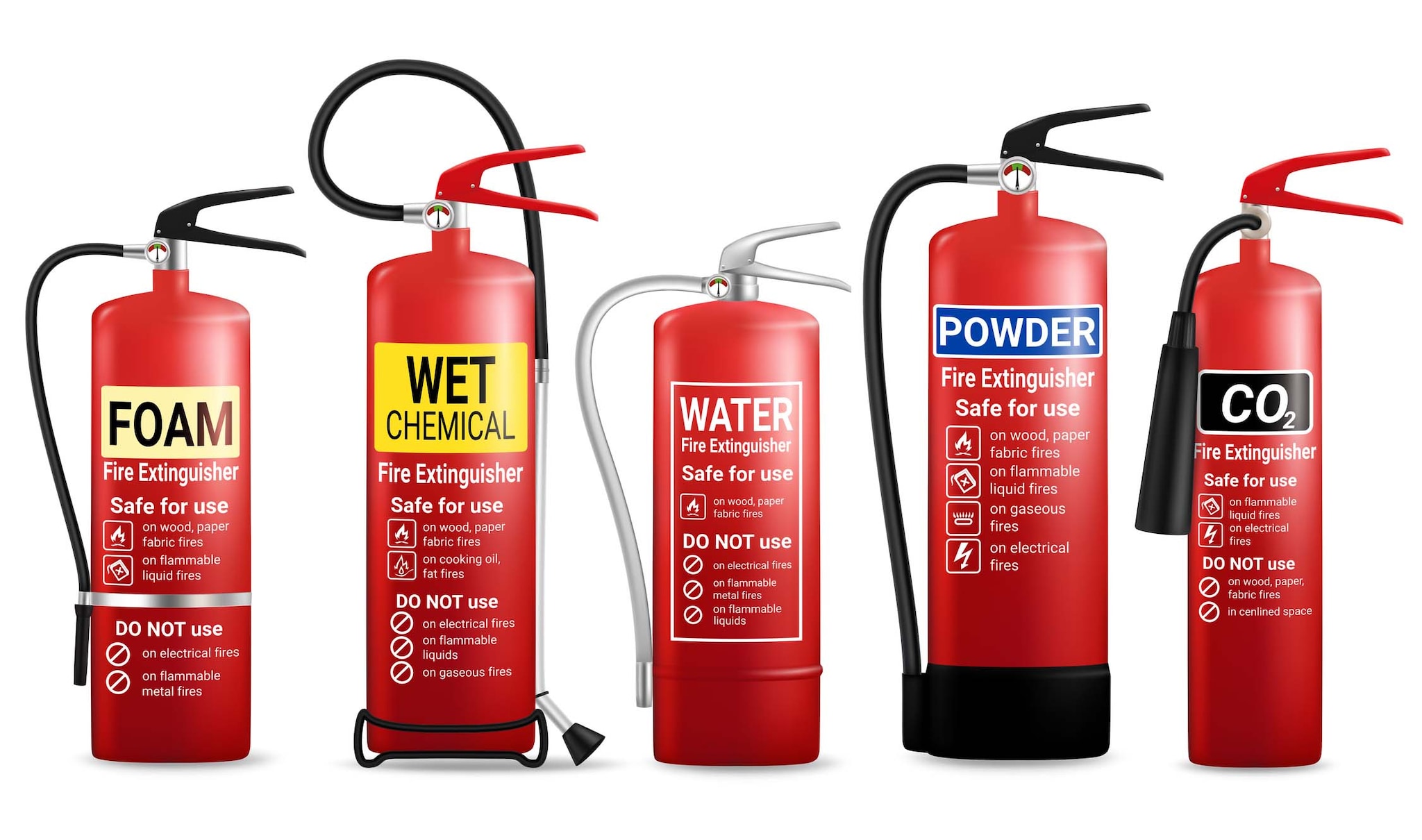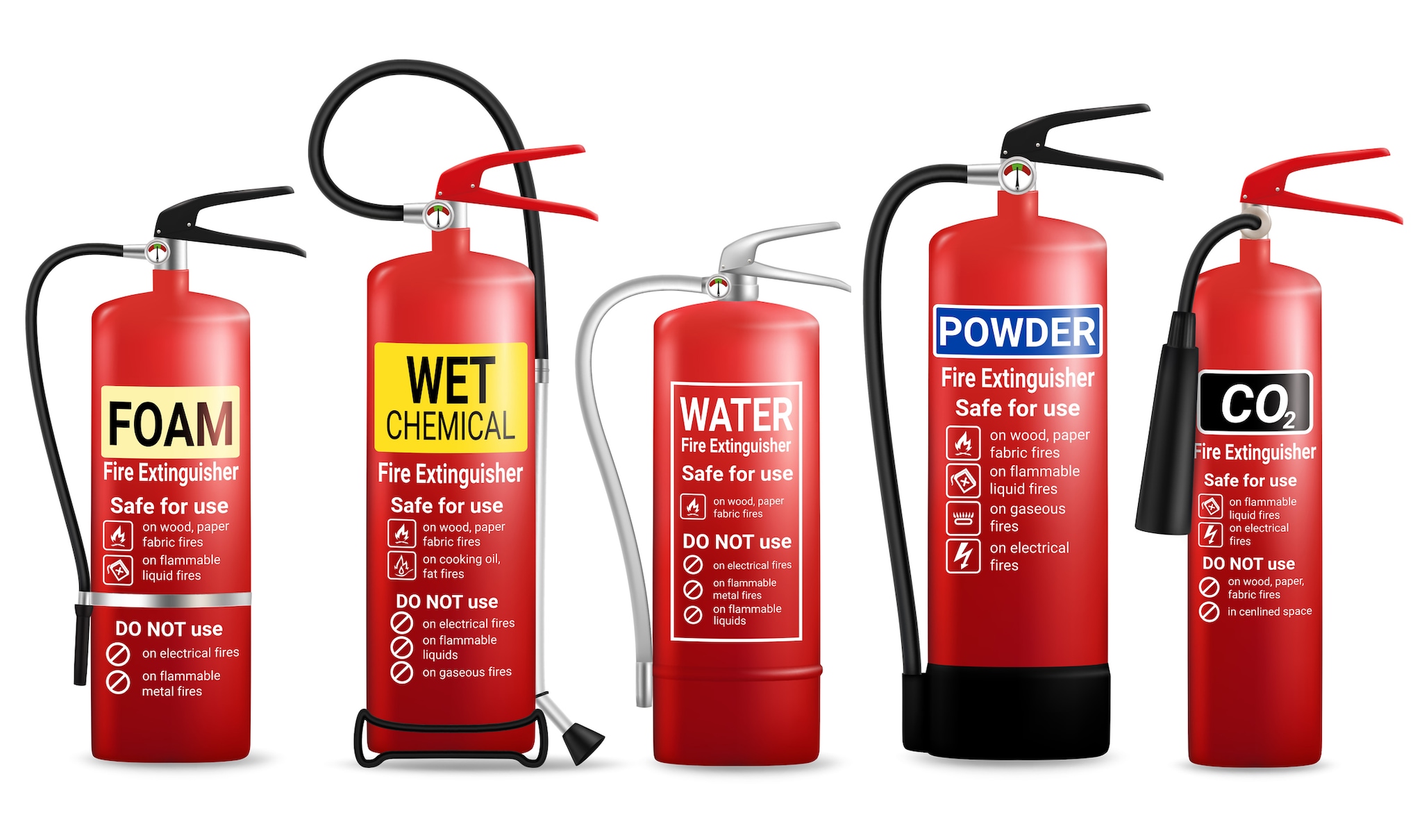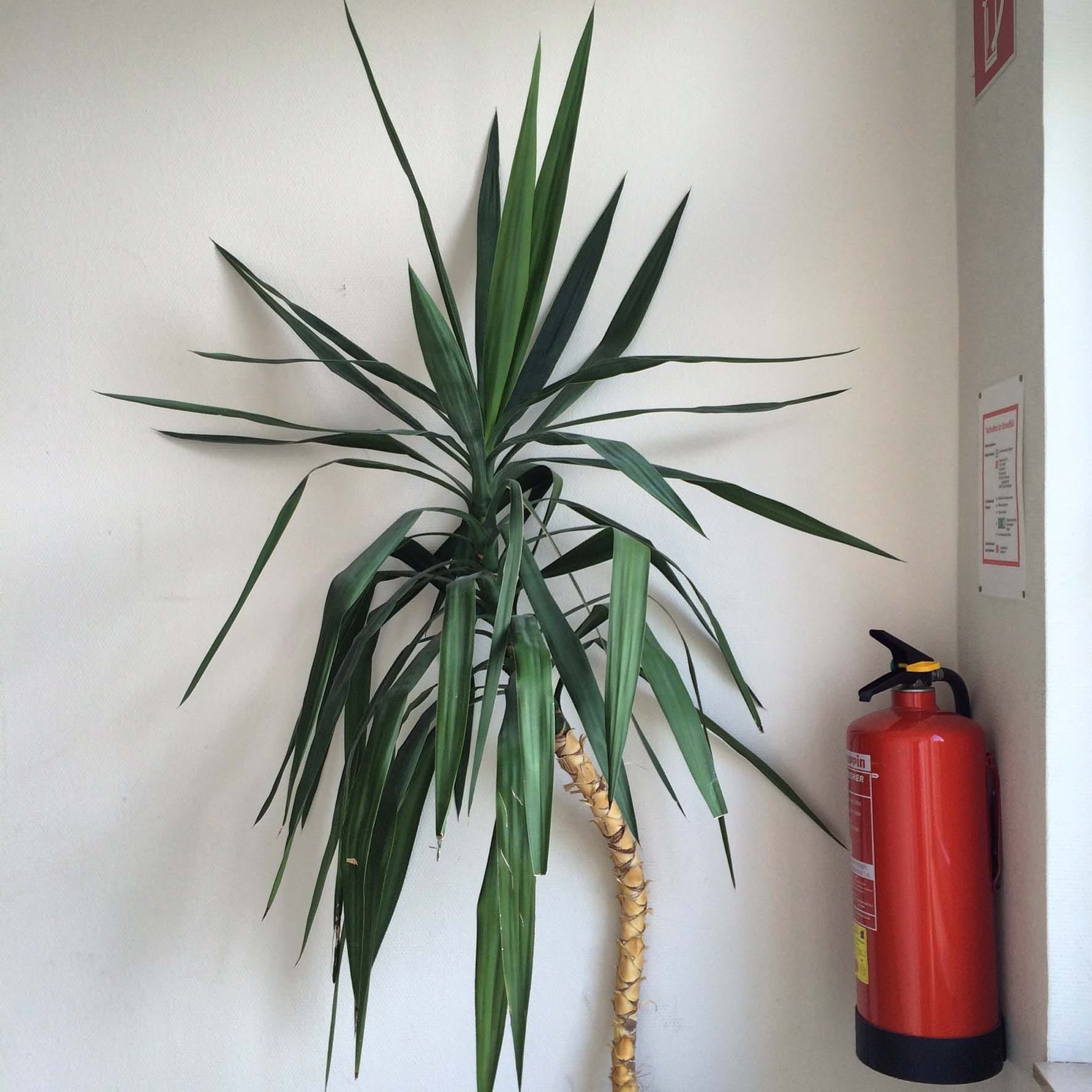Do you know what to do if a fire starts?
Knowing how to use a fire extinguisher could save your home. You should only use a fire extinguisher for a small, manageable flame, and only after you’ve learned how to handle it.
We’ll go over how a fire extinguisher works and how you can find the right extinguisher for your home.
What are the different fire extinguisher parts?
Even though there are several types of fire extinguishers, the parts are similar between different models. Knowing the different components of an extinguisher can help understand how to use it better.
So, what makes up a fire extinguisher?
- Tank or cylinder: The tank is the main part of a fire extinguisher. It contains the extinguishing agent and propellant gas.
- Valve assembly: The valve regulates the extinguishing agent.
- Safety or locking pin: This pin keeps your fire extinguisher locked, so you don’t accidentally engage it during transport.
- Handle: You use the handle to transport and hold the extinguisher.
- Tamper seal: This seal wraps around the safety pin and keeps it in place, so the extinguisher doesn’t accidentally go off.
- Pressure gauge: This shows the pressure of the extinguishing agent. Your pressure should be green. Note: CO2 extinguishers don’t have a pressure gauge.
- Release lever or trigger: The extinguishing agent goes through the hose or nozzle when you press or pull the lever.
- Nozzle or hose: Smaller tanks have a nozzle and larger tanks have a hose. These function similarly, expelling and directing the extinguishing agent towards the fire.
- Extinguishing agent: This is the stuff that comes out of the extinguisher to suppress a fire. It could be water, foam or dry powder depending on the type of extinguisher.
- Propellent: This is the gas that expels the extinguishing agent.


How does a fire extinguisher work?
For a fire to burn, it needs three key elements:
- Oxygen to feed the flames.
- Heat that gets the fire into an ignitable state.
- Fuel that keeps the fire burning.
This is typically referred to as the fire triangle. When these three elements combine, they create a chemical reaction: fire.
Remove one of these elements, and the fire becomes unsustainable.
Foam extinguishers
A foam fire extinguisher is made with a combination of foam concentrate, water and air. The thick foam smothers the oxygen from the flames and cools the fire down.
- Identification: Cream-colored label that says “FOAM.”
- Used for: Class A or Class B fires.
- Drawbacks: Can be very messy to clean up and often leaves a residue.
- When should you use a foam extinguisher? On flammable liquids like petrol, diesel, solvents or paint, as well as organic solids including paper, wood, textiles, fabrics, cardboard and furniture.
- What should you never use a foam extinguisher on? Flammable metals, grease fires or electrical fires.
Dry powder extinguishers
Dry powder extinguishers cover the fire’s fuel, separating it from the oxygen element of the fire triangle. It also works by eliminating the heat from a flame.
- Identification: Blue-colored label that says “POWDER.”
- Used for: Class D fires.
- Drawbacks: There’s a higher risk of inhalation in small spaces because of the fine powder.
- When should you use a dry powder extinguisher? On flammable metals like magnesium. You should also use them outdoors or in large (open) warehouses.
- What should you never use a dry powder extinguisher on? Anything involving cooking oil or electrical equipment over 1000v, or in small or enclosed spaces.
Dry chemical fire extinguishers
Dry chemical extinguishers are multipurpose. This means you can use it with type A, B or C fires, depending on the type of extinguisher.
These extinguishers put out a fire with a foam that separates the fuel from oxygen in A fires and also interrupts the chemical reaction of fire in A, B or C fires.
- Identification: Blue-colored label that says “DRY CHEM,” “ABC” or “BC.”
- Used for: Class A, B or C fires, depending on the label.
- Drawbacks: Once you discharge the foam, it can cause visibility issues. We don’t recommend using it around people with upper respiratory conditions or in small spaces.
- When should you use a dry chemical fire extinguisher? Read the manufacturer’s label to determine what your extinguisher can handle, since it will differ depending on the type of dry chemical extinguisher.
- A materials include combustibles like wood, leaves, fabrics, solid plastics, paper or cloth.
- B materials include flammable liquids and gases like petrol, acetone and grease, and liquid petroleum gasses like butane and methane.
- These extinguishers can also fight fires caused by electrical equipment—but only up to 1000v.
- What should you never use a dry chemical extinguisher on? Cooking fires that involve grease or electrical equipment over 1000v. You should never use these extinguishers in enclosed spaces, either.
Water extinguishers
Water extinguishers are best for Class A fires. They cover the fire in water, cooling the heat until the fuel can no longer burn and the flames go out.
- Identification: White-colored font on a red tank that says “WATER.”
- Used for: Class A fires.
- Drawbacks: Since these extinguishers use water, there is a risk of the water inside freezing in colder climates. There is also a potential risk of shock if used on an electrical fire.
- When should you use a water extinguisher? Solid combustibles like wood, leaves, plastic, straw, fabrics, solid plastics, paper or cloth.
- What should you never use a water extinguisher on? Electrical fires or flammable liquids like petrol or paints.
There are four main types of water extinguishers: Water spray, water jet, water mist and water spray with additives. These handle different fires, so it’s important to always read the label.
Wet chemical extinguishers
People typically use a wet chemical fire extinguisher in commercial kitchens to fight fires caused by ignited grease or fats. These extinguishers have a thick, soapy foam that stops oxygen from reaching the flames.
Some wet chemical extinguishers can also fight Class A fires (wood, paper) or Class B (paint, petrol) fires, though a foam or water extinguisher is more common.
- Identification: Yellow-colored label that says “WET CHEMICAL.”
- Used for: Class F fires; check the manufacturer’s label and see if you can use the wet chemical extinguisher with Class A or Class B materials.
- Drawbacks: You should always use wet chemical fire extinguishers in a well-ventilated area because of the possibility of fumes.
- When should you use a wet chemical extinguisher? On cooking oils and fats. You can use some wet chemical extinguishers on organic compounds, including fabric, wood, cardboard or paper, depending on the specific wet chemical extinguisher.
- What should you never use a wet chemical extinguisher on? Use them when cooking oils and fats catch fire. You can use some wet chemical extinguishers on organic compounds, including fabric or wood, but check that your extinguisher is compatible with these materials before use.
Carbon dioxide extinguishers
CO2 extinguishers are commonly placed in office or server rooms. They are most often used on electrical fires because they won’t damage electronic equipment. You can also use them on Class B fires, but they pose a risk of re-ignition.
They work by replacing the oxygen that the fire needs, preventing it from igniting.
- Identification: Black-colored label that says “CO2.”
- Used for: Electrical equipment and Class B fires.
- Drawbacks: There’s a risk of cold burning or frostbite if improperly handled. Since these extinguishers are made with CO2 , there’s an increased risk of suffocation in small spaces.
- When should you use a carbon dioxide extinguisher? In offices, server rooms and businesses with electrical equipment.
- What should you never use a carbon dioxide extinguisher on? Cooking or grease fires and in enclosed spaces. They are also ineffective against flammable solids. Contents are under pressurized carbon dioxide gas, so they may blast or explode grease fires if you attempt to use one on a grease fire.
How to choose the right fire extinguisher
According to the NFPA, there are five principle causes of house fires [1].
1. Cooking
2. Heating appliances
3. Electrical and lighting equipment
4. Intentional fires
5. Smoking materials
You’ll want to choose the right fire extinguisher for your home that can handle a kitchen fire and an electrical fire. Consider multipurpose fire extinguishers for your home and more specialized extinguishers if you have a garage or workshop.
Here’s a handy chart to help you understand different fire classes.
Different Kinds of Fire Extinguishers
Type of Fire Extinguisher |
What it’s Used For |
Class A |
Ordinary combustibles like wood, cloth, plastic or paper. |
Class B |
Combustible liquids, gasses, grease, oil, gasoline, alcohol or propane. |
Class C |
Electrical fires from appliances, tools or wires. |
Class D |
Flammable metals such as titanium, sodium, magnesium or potassium. |
Class K |
Vegetable-based oils and animal fats used in cooking. |
Multipurpose BC |
Flammable liquids or gasses, or electrical fires. They are designed to extinguish B and C fires.. |
Multipurpose ABC |
Fires that involve ordinary combustibles, flammable liquids, gasses or electrical equipment. They are designed to extinguish A, B, and C fires. |
How do you use a fire extinguisher?
Every adult household member should know how to use a fire extinguisher. FEMA has a handy acronym that the NFPA recommends to help you remember the steps of operating an extinguisher: P.A.S.S [2]
1. If a fire breaks out, you should first alert the fire department, in case the fire gets out of control, before trying to fight the fire yourself [3].
2. Pull the fire extinguisher ring/safety pin. Point the nozzle away from you and towards the fire before releasing the locking pin.
3. Aim carefully, pointing the nozzle towards the base of the fire. Don’t forget to stay a safe distance away from the flames as you activate the extinguisher.
4. Squeeze the handle slowly and evenly, releasing the extinguishing agent.
5. Sweep the nozzle left to right, slowly moving towards the fire as it goes out. Be alert, in case the fire re-ignites.
6. Once the fire is out, leave the area so it has time to ventilate. Lingering fumes or smoke can be dangerous to your health.
7. Give details to the fire department. If you’ve contained the fire, let them know. They will want to confirm there aren’t any lingering sparks that could re-ignite.
8. Wait until the fire department has cleared your home before going back inside.


Where should you put a fire extinguisher in your home?
When choosing the proper fire extinguisher placement, consider the size of the canister and where your exits are located. You don’t want to get trapped in a room because you’ve gone back to fight a fire, and your exit is cut off.
1. The fire extinguisher should be easily accessible along evacuation routes.
2. Install your fire extinguisher where it’s clearly visible.
3. Consider placing a fire extinguisher on every floor of a residence.
4. If you must place a fire extinguisher in an area where it’s partially blocked or inside a cabinet, add a sign and list exactly where the extinguisher is located.
5. NFPA recommends putting extinguishers at least four inches from the ground and up to five feet [4].
6. If your fire extinguisher is larger than 40 lb., put it a maximum of 3’6” from the ground, so it’s easier to manage and remove from the wall.
7. Wheeled fire extinguishers don’t have to be mounted on the wall since the wheels provide a buffer from the floor.
8. Keep at least one fire extinguisher in or near the kitchen. You should also add one to your garage, basement or workshop.
How do you put a fire extinguisher on the wall?
Only use hardware specifically for fire extinguishers. Your fire extinguisher should come with a fire extinguisher bracket and other hardware.
1. Figure out where you want to install the fire extinguisher, depending on height preference and visibility.
2. Align the bracket against the wall and mark the holes with a pencil.
3. Drill holes where you added the pencil marks, using a leveler if desired.
4. Align the mounting hardware and secure the bracket into place.
5. Snap the fire extinguisher into the wall mount.
Do fire extinguishers need to be maintained?
Like most appliances in your home, a fire extinguisher needs an occasional inspection to ensure it’s working. Inspect your extinguisher the first time you set it up, and then monthly thereafter [5].
Keep a record of your inspections, writing the month, year and name of the person who inspected the extinguisher. Keep these records for at least 12 months.
Fire extinguisher location.
Is your extinguisher easy to access and use in an emergency? If you have an extinguisher cabinet, show the type of extinguisher. You should display fire extinguisher instructions in an area where you can clearly read them.
Do a visual check.
Ensure that the canister, hoses, seals, nozzles, and other parts are free from rust, dents, cracks or other damage. Be on the lookout for any corrosion, leaks or nozzle clogs.
Check that the pressure level is in a normal range.
Your extinguisher’s pressure should be in the green level, not too high and not too low. Check the manufacturer’s instructions for the correct gauge level.
Keep your extinguisher clean.
Wipe off any dust or grease with a soft cloth.
Check the manufacturer’s instructions for any special instructions.
Some models may require you to shake the contents monthly or test the pressure.
How often should you examine your fire extinguisher?
A qualified maintenance professional should do an internal examination of the extinguisher.
- Do a thorough examination and pressure test at least once a year.
- If an extinguisher needs to be recharged, recharge it approximately every three years. Every time your rechargeable fire extinguisher has maintenance, it will need a new tamper seal.
- You will need to do an internal test every six years for most fire extinguishers.
- Some stored-pressure extinguishers require a hydrostatic test every 12 years. (e.g., dry chemical extinguishers).
- Check pressure-loaded steam and antifreeze extinguishers every year.
- Inspect carbon dioxide extinguishers and wet extinguishers every five years.
[Source 6]
Do fire extinguishers expire?
Fire extinguishers rarely have a tried-and-true expiration date, but they dp have a general life expectancy. You should upgrade nonchargeable extinguishers approximately every 12 years [6]. Follow the manufacturer’s instructions for your model.
Look for a label or stamped date along the body of the extinguisher. You might find this label imprinted directly onto the extinguisher's body or printed and attached somewhere else on the extinguisher.
How do you dispose of a fire extinguisher?
You can use many portable residential fire extinguishers only once, though commercial-grade and CO2 extinguishers can be refillable.
The manufacturer’s instructions on your extinguisher should list how to empty any leftover firefighting contents. You’ll want to do this before disposing of your extinguisher.
If your extinguisher is charged but empty, you may be able to drop it off at your local fire department for recycling. Call your local fire department to see if they accept drop-offs.
Otherwise, you’ll want to dispose of old or used fire extinguishers at a local Hazardous Waste Collection site.
ADT can help protect your home from fire damage with smoke detectors
Monitored ADT home safety means that when a fire breaks out or a carbon monoxide leak happens, our smart devices send you and the monitoring team an alert. If it’s a real hazard and not a false alarm, or if they can’t get hold of you, our monitoring centers quickly contact first responders.
Get reliable life safety detection with ADT.
Frequently Asked Questions About Fire Extinguishers
What do the symbols on a fire extinguisher show?
Fire extinguishers come with different colored labels and symbols representing the type of fire extinguisher and what it can be used for.
Which gas is used in a fire extinguisher?
Most fire extinguishers use carbon dioxide gas or dry nitrogen gas as the propelling agent in a fire extinguisher.
Where can you recharge a fire extinguisher?
You can recharge your fire extinguisher for a fee at a certified equipment dealer or a local fire department. Follow your service instructions from the manual.
What size fire extinguisher do you need?
A 5-lb fire extinguisher is ideal for a residence, while 2-lb is best for vehicles. You’ll want something larger in a commercial space or warehouse, so you should look for a 10-lb.
Resources:
[1] https://www.nfpa.org/News-and-Research/Data-research-and-tools/Building-and-Life-Safety/Home-Structure-Fires
[2] https://www.nfpa.org/Public-Education/Staying-safe/Safety-equipment/Fire-extinguishers
[3] https://www.abingtonma.gov/fire-department/faq/i-have-a-fire-extinguisher-should-i-try-to-put-the-fire-out-myself-before-i-call
[4] https://www.nfpa.org/News-and-Research/Publications-and-media/Blogs-Landing-Page/NFPA-Today/Blog-Posts/2021/04/30/Extinguisher-Placement-Guide
[5] https://www.nfpa.org/news-and-research/publications-and-media/blogs-landing-page/nfpa-today/blog-posts/2020/10/30/guide-to-fire-extinguisher-inspection-testing-and-maintenance
[6] https://www.health.state.mn.us/facilities/regulation/engineering/docs/lscfireext.pdf
Related Articles:


